Abstract
Nanoindentation techniques have recently been adapted for the study of biological materials. This feature will consider the experimental adaptations required for such studies. Following a brief review of the structure and constitutive behavior of biological materials, we examine the experimental aspects in detail, including working with hydrated samples, time-dependent mechanical behavior and extremely compliant materials. The analysis of experimental data, consistent with the constitutive response of the material, will then be treated. Examples of nanoindentation data collected using commercially-available instruments are shown, including nanoindentation creep curves of biological materials and relaxation responses of biomimetic hydrogels. Finally, we conclude by examining the current state and future needs of the biological nanoindentation community.
Similar content being viewed by others
References
Cook, R.F., “Probing the Nanoscale,” Science 328:183–184 (2010).
Ebenstein, D., and Pruitt, L., “Nanoindentation of Biological Materials,” Nano Today 1:26–33 (2006).
Hay, J., “Introduction to Instrumented Indentation Testing,” Experimental Techniques 33(6):66–72 (2009).
Hay, J., Agee, P., and Herbert, E., “Continuous Stiffness Measurement during Instrumented Indentation Testing,” Experimental Techniques 34(3):86–94 (2010).
Constantinides, G., Ravi Chandran, K.S., Ulm, F.-J., and van Vliet, K.J., “Grid Indentation Analysis of Composite Microstructure and Mechanics: Principles and Validation,” Materials Science and Engineering A-Structural Materials Properties Microstructure and Processing 430:189–202 (2006).
Cuy, J.L., Mann, A.B., Livi, K.J., Teaford, M.F., and Weihs, T.P., “Nanoindentation Mapping of the Mechanical Properties of Human Molar Tooth Enamel,” Archives of Oral Biology 47:281–291 (2002).
Gentleman, E., Swain, R.J., Evans, N.D., et al. “Comparative Materials Differences Revealed in Engineered Bone as a Function of Cell-Specific Differentiation,” Nature Materials 8:763–770 (2009).
Olesiak, S.E., Sponheimer, M., Eberle, J., Oyen, M.L., and Ferguson, V.L., “Nanomechanical Properties of Modern and Fossile Bone,” Palaeogeography, Palaeoclimatology, Palaeoecology 289:25–32 (2010).
Lyyra, T., Jurvelin, J., Pitkanen, P., Vaatainen, U., and Kiviranta, I., “Indentation Instrument for the Measurement of Cartilage Stiffness under Arthroscopic Control,” Medical Engineering and Physics 17:395–399 (1995).
Nover, A.B., Jagtap, S., Anjum, W., et al. “Modern Breast Cancer Detection: A Technological Review,” International Journal of Biomedical Imaging 2009:902326 (2009).
Oyen, M.L., “The Materials Science of Bone: Lessons from Nature for Biomimetic Materials Synthesis,” Materials Research Bulletin 33:49–55 (2008).
Hunter, G.K., “Interfacial Aspects of Biomineralization,” Current Opinion in Solid State and Materials Science 1:430–435 (1996).
Mow, V.C., Gu, W.Y., and Chen, F.H., “Structure and function of articular cartilage and meniscus,” Mow, V.C., and Huiskes, R. (eds), Basic Orthopaedic Biomechanics and Mechanobiology, 3rd Edition, Lippincott, Williams and Wilkins, Philadelphia (2005).
Oyen, M.L., Ko, C.-C., Bembey, A.K., Bushby, A.J., and Boyde, A., “Nanoindentation and Finite Element Analysis of Resin-Embedded Bone Samples as a Three-Phase Composite Material,” Materials Research Society Symposium Proceedings 874:71.7.1 (2005).
Meyers, M.A., Chen, P., Lin, A.Y., and Seki, Y., “Biological Materials: Structure and Mechanical Properties,” Progress in Materials Science 53:1–206 (2008).
Oyen, M.L., Ferguson, V.L., Bembey, A.K., Bushby, A.J., and Boyde, A., “Composite Bounds on the Elastic Modulus of Bone,” Journal of Biomechanics 41:2585–2588 (2008).
Tai, K., Dao, M., Suresh, S., Palazoglu, A., and Ortiz, C., “Nanoscale Heterogeneity Promotes Energy Dissipation in Bone,” Nature Materials 6:454–462 (2007).
Currey, J.D., Bones: Structure and Mechanics, Princeton University Press, New Jersey (2002).
Jackson, A.P., Vincent, J.F., and Turner, R.M., “The Mechanical Design of Nacre,” Proceedings of the Royal Society of London, Series B, Biological Sciences 234:415–440 (1988).
Nys, Y., Gautron, J., Garcia-Ruiz, J.M., and Hincke, M.T., “Avian Eggshell Mineralization: Biochemical and Functional Characterization of Matrix Proteins,” Comptes Rendus Palevol 3:549–562 (2004).
Ferguson, V.L., Bushby, A.J., and Boyde, A., “Nanomechanical Properties and Mineral Concentration in Articular Calcified Cartilage and Subchondral Bone,” Journal of Anatomy 203:191–202 (2003).
Kavukcuoglu, N.B., Patterson-Buckendahl, P., and Mann, A.B., “Effect of Osteocalcin Deficiency on the Nanomechanics and Chemistry of Mouse Bones,” Journal of the Mechanical Behavior of Biomedical Materials 2:348–354 (2009).
Tesch, W., Eidelman, N., Roschger, P., Goldenberg, F., Klaushofer, K., and Fratzl, P., “Graded Microstructure and Mechanical Properties of Human Crown Dentin,” Calcified Tissue International 69:147–157 (2001).
Rho, J.-Y., Tsui, T.Y., and Pharr, G.M., “Elastic Properties of Human Cortical and Trabecular Lamellar Bone Measured by Nanoindentation,” Biomaterials 18:1325–1330 (1997).
Lin, D.C., Shreiber, D.I., Dimitriadis, E.K., and Horkay, F., “Spherical Indentation of Soft Matter Beyond the Hertzian Regime: Numerical and Experimental Validation of Hyperelastic Models,” Biomech Model Mechanobiol 8:345–358 (2009).
Oyen, M.L., “Indentation of Nonlinearly Viscoelastic Solids,” Materials Research Society Symposium Proceedings 1049:1049-AA06-06 (2007).
Wang, H.W., Theory of Linear Poroelasticity with Applications to Geomechanics and Hydrogeology, Princeton University Press, Princeton, NJ (2000).
Mak, A.F., Lai, W.M., and Mow, V.C., “Biphasic Indentation of Articular Cartilage–I. Theoretical Analysis,” Journal of Biomechanics 20:703–714 (1987).
Swadener, J.G., Rho, J.-Y., and Pharr, G.M., “Effects of Anisotropy on Elastic Moduli Measured by Nanoindentation in Human Tibial Cortical Bone,” Journal of Biomedical Materials Research 57:108–112 (2001).
Nikonov, A., Davies, A.R., and Emri, I., “The Determination of Creep and Relaxation Functions from a Single Experiment,” Journal of Rheology 49:1193–1211 (2005).
Chung, K.-Y., Bhadriraju, K., Spurlin, T.A., Cook, R.F., and Plant, A.L., “Nanomechanical Properties of Thin Films of Type I Collagen Fibrils,” Langmuir 26:3629–3636 (2010).
Johnson, K.L., Contact Mechanics, Cambridge University Press, UK (1985).
Kaufman, J.D., and Klapperich, C.M., “Surface Detection Errors cause Overestimation of the Modulus in Nanoindentation on Soft Materials,” Journal of the Mechanical Behavior of Biomedical Materials 2:312–317 (2009).
Bembey, A.K., Oyen, M.L., Bushby, A.J., and Boyde, A., “Viscoelastic Properties of Bone as a Function of Hydration State Determined by Nanoindentation,” Philosophical Magazine 86:5691–5703 (2006).
Bembey, A.K., Bushby, A.J., Boyde, A., Ferguson, V.L., and Oyen, M.L., “Hydration Effects on the Micro-Mechanical Properties of Bone,” Journal of Materials Research 21:1962–1968 (2006).
Oyen, M.L., “Poroelastic Nanoindentation Responses of Hydrated Bone,” Journal of Materials Research 23:1307–1314 (2008).
Bushby, A.J., Ferguson, V.L., and Boyde, A., “Nanoindentation of Bone: Comparison of Specimens Tested in Liquid and Embedded in Polymethylmethacrylate,” Journal of Materials Research 19:249–259 (2004).
Hoffler, C.E., Moore, K.E., Kozloff, K., Zysset, P.K., Brown, M.B., and Goldstein, S.A., “Heterogeneity of bone lamellar-level elastic moduli,” Bone 26:603–609 (2000).
Hoffler, C.E., Guo, X.E., Zysset, P.K., and Goldstein, S.A., “An Application of Nanoindentation Technique to Measure Bone Tissue Lamellae Properties,” Journal of Biomechanical Engineering 127:1046–1053 (2005).
Lucas, B.N., Oliver, W.C., Pharr, G.M., and Loubet, L.-L., “Time-Dependent Deformation During Indentation Testing,” Materials Research Society Symposium Proceedings 436:233–238 (1997).
Oyen, M.L., and Cook, R.F., “Load-Displacement Behavior During Sharp Indentation of Viscous-Elastic-Plastic Materials,” Journal of Materials Research 18:139–150 (2003).
Kaufman, J.D., Miller, G., Morgan, E.F., and Klapperich, C.M., “Time-Dependent Mechanical Characterization of Poly(2-hydroxyethyl methacrylate) Hydrogels Using Nanoindentation and Unconfined Compression,” Journal of Materials Research 23:1472–1481 (2008).
Oliver, W.C., and Pharr, G.M., “Improved Technique for Determining Hardness and Elastic Modulus using Load and Displacement Sensing Indentation Experiments,” Journal of Materials Research 7:1564–1583 (1992).
Briscoe, B.J., Fiori, L., and Pelillo, E., “Nano-Indentation of Polymeric Surfaces,” Journal of Physics D: Applied Physics 31:2395–2405 (1998).
Chudoba, T., and Richter, F., “Investigation of Creep Behavior under Load During Indentation Experiments and its Influence on Hardness and Modulus Results,” Surface and Coatings Technology 148:191–198 (2001).
Tang, B., Ngan, A.H.W., and Lu, W.W., “Viscoelastic Effects during Depth-Sensing Indentation of Cortical Bone Tissues,” Philosophical Magazine 86:5653–5666 (2006).
Cheng, Y.T., and Cheng, C.M., “Relationships between Initial Unloading Slope, Contact Depth, and Mechanical Properties for Spherical Indentation in Linear Viscoelastic Solids,” Materials Science and Engineering: A 409:93–99 (2005).
Findley, W.N., Lai, J., and Onaran, K., Creep and Relaxation of Nonlinear Viscoelastic Materials, Dover, New York (1989).
Lee, E.H., and Radok, J.R.M., “Contact Problem for Viscoelastic Bodies,” Journal of Applied Mechanics 27:438–444 (1960).
Oyen, M.L. (ed), Handbook of Nanoindentation with Biological Applications, Pan Stanford Publishing, Singapore (2010).
Lu, H., Wang, B., Ma, J., Huang, G., and Viswanathan, H., “Measurement of Creep Compliance of Solid Polymers by Nanoindentation,” Mechanics of Time-Dependent Materials 7:189–207 (2003).
Oyen, M.L., “Spherical Indentation Creep Following Ramp Loading,” Journal of Materials Research 20:2094–2100 (2005).
Oyen, M.L., “Analytical Techniques for Indentation of Viscoelastic Materials,” Philosophical Magazine 86:5625–5641 (2006).
Tweedie, C.A., and Van Vliet, K.J., “Contact Creep Compliance of Viscoelastic Materials via Nanoindentation,” Journal of Materials Research 21:1576–1589 (2006).
Galli, M., Comley, K.S.C., Shean, T.A.V., and Oyen, M.L., “Viscoelastic and Poroelastic Mechanical Characterization of Hydrated Gels,” Journal of Materials Research 24:973–979 (2009).
Mattice, J.M., Lau, A.G., Oyen, M.L., and Kent, R.W., “Spherical Indentation Load-Relaxation of Soft Biological Tissues,” Journal of Materials Research 21:2003–2010 (2006).
Lau, A.G., Oyen, M.L., Kent, R.W., Murakami, D., and Torigaki, T., “Indentation Stiffness of Aging Human Costal Cartilage,” Acta Biomaterials 4:97–103 (2008).
Hauch, K.N., Oyen, M.L., Odegard, G.M., and Haut Donahue, T.L., “Nanoindentation of the Insertional Zones of Human Meniscal Attachments into Underlying Bone,” Journal of the Mechanical Behavior of Biomedical Materials 2:339–347 (2008).
Zhang, C.Y., Zhang, Y.W., Zeng, K.Y., and Shen, L., “Nanoindentation of Polymers with a Sharp Indenter,” Journal of Materials Research 20:1597–1605 (2005).
Oyen, M.L., and Ko, C.-C., “Examination of Local Variations in Viscous, Elastic, and Plastic Indentation Responses in Healing Bone,” Journal of Materials Science: Materials in Medicine 18:623–628 (2007).
Olesiak, S.E., Oyen, M.L., and Ferguson, V.L., “Viscous-Elastic-Plastic Behavior of Bone using Berkovich Nanoindentation,” Mechanics of Time-Dependent Materials 14:111–124 (2010).
Hu, Y., Zhao, X., Vlassak, J.J., and Suo, Z., “Using Indentation to Characterize the Poroelasticity of Gels,” Applied Physics Letter 96:121904 (2010).
Gupta, S., Lin, J., Ashby, P., and Pruitt, L., “A Fiber Reinforced Poroelastic Model of Nanoindentation of Porcine Costal Cartilage: A Combined Experimental and Finite Element Approach,” Journal of the Mechanical Behavior of Biomedical Materials 2:326–338 (2009).
Galli, M., and Oyen, M.L., “Fast Identification of Poroelastic Parameters from Indentation Tests,” Computer Modeling in Engineering and Sciences (CMES) 48:241–268 (2009).
Galli, M., and Oyen, M.L., “Spherical Indentation of a Finite Poroelastic Coating,” Applied Physics Letter 93:031911 (2008).
Rar, A., Song, H., and Pharr, G.M., “Assessment of New Relation for the Elastic Compliance of a Film-Substrate System,” Materials Research Society Symposium Proceedings 695:L10.10.1-6 (2002).
Zhang, C.Y., Zhang, Y.W., and Zeng, K.Y., “Extracting the Mechanical Properties of a Viscoelastic Polymeric Film on a Hard Elastic Substrate,” Journal of Materials Research 19 (10):3053–61 (2004).
Oyen, M.L., Cook, R.F., Moody, N.R., and Emerson, J.A., “Indentation Responses of Time-Dependent Films on Stiff Substrates,” Journal of Materials Research 19:2487–2497 (2004).
Author information
Authors and Affiliations
Corresponding author
Rights and permissions
About this article
Cite this article
Oyen, M.L. Nanoindentation of biological and biomimetic materials. Exp Tech 37, 73–87 (2013). https://doi.org/10.1111/j.1747-1567.2011.00716.x
Received:
Accepted:
Published:
Issue Date:
DOI: https://doi.org/10.1111/j.1747-1567.2011.00716.x




